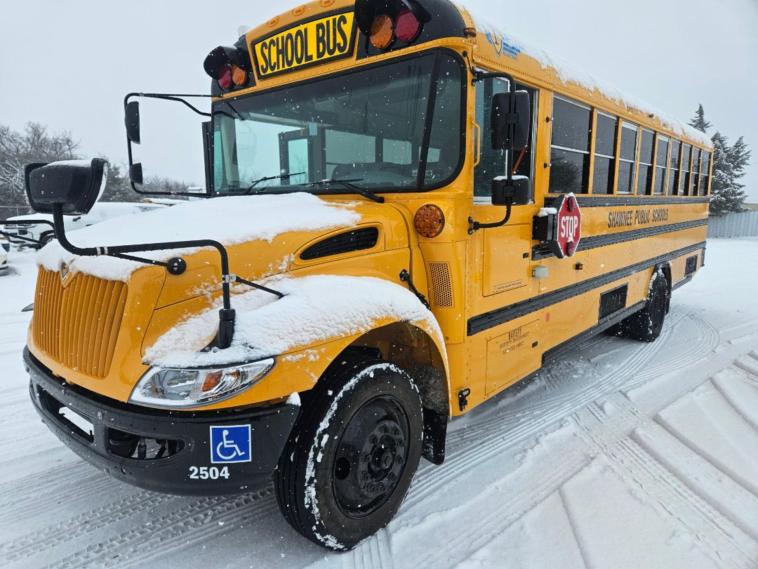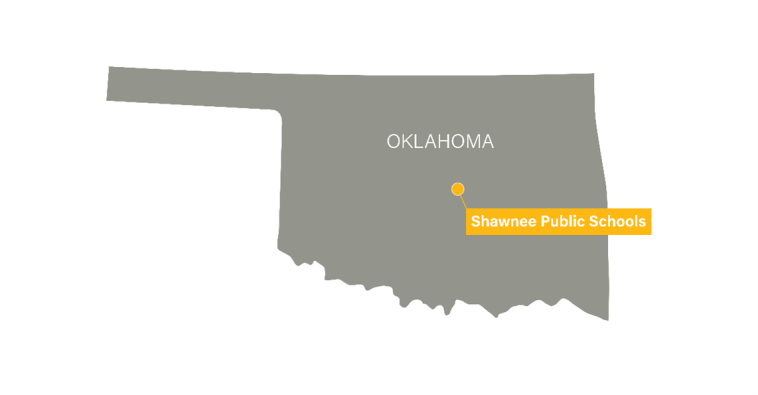Building Resilience With Electric School Buses in Rural Oklahoma
Through strong partnerships, tornado-prone Shawnee Public Schools District is using electric school buses to prepare for future emergencies while also providing a quieter ride for the community.

When Shawnee Public Schools (SPS) began converting its school bus fleet to electric in 2023, the district was mainly focused on a few key benefits: saving money on fuel and maintenance costs, reducing air pollution for its students and community and more.
But after a tornado struck Shawnee in 2023, destroying much of the town’s electric infrastructure and leaving the community without power for 10 days, conversations began about how to leverage an unexpected benefit of SPS’ new electric school buses: their ability to store and distribute power. Bidirectional charging technology can assist during similar disasters by using electricity from electric school buses to power hospitals, schools and other facilities in case of emergency.
| Shawnee Public Schools | |
| Location | Shawnee, Oklahoma |
| Number of students | -3,500 students |
| Number of schools | 8 |
| Percentage of students who ride the bus | 45% |
| Fleet size | 16 school buses |
| Number of electric school buses in fleet | 8 electric school buses |
Strong relationships are crucial for any successful deployment of electric school buses. Shawnee Public Schools’ especially strong relationship with utility Oklahoma Gas & Electric (OG&E) has helped them collaborate to prepare for a more resilient future.
Why Shawnee Public Schools chose electric school buses
SPS began converting its fleet to electric in 2023 and has since transitioned eight buses – half its fleet – to electric, including two wheelchair-accessible buses. Located in rural Oklahoma, about an hour east of Oklahoma City, and co-located with Tribal Nations, SPS is comprised of eight schools serving around 3,500 students including students of the Citizen Potawatomi Nation, Choctaw Nation, Muscogee (Creek) Nation, Absentee Shawnee Tribe, Sac & Fox Nation, Kickapoo Tribe, Iowa Nation (Baxoje) and Seminole Tribe.

Electric school buses first appealed to the district because of the prospective fuel and overall savings. Now that half of their fleet is electric, they saved $40,900 in fuel costs alone during the 2024-2025 school year, not to mention additional savings on maintenance costs.
Clean air benefits also motivated the district to electrify its fleet, in alignment with a limited-idling policy the school district adopted in 2011 to reduce pollution from diesel-burning school buses, which can create breathing problems for students riding them.

Once SPS got their electric school buses on the road, several unexpected benefits became evident. The school district intentionally deployed electric school buses on routes that reported more student behavioral issues. After doing so, drivers noted that student behavior on the electric school buses is noticeably better than on the diesel-burning school buses that were deployed on those same routes initially. Between the 2022-23 and the 2024-25 school years, there was nearly a 50% reduction in reported behavioral incidents for routes that switched to electric.
Drivers also observed that the quieter electric school buses are making a difference for students with sensory sensitivities, allowing some to return to riding the bus to school after previously opting out.
Drivers have noted that student behavior inside the electric school buses noticeably improved, compared to student behavior on a diesel-burning school bus.
And with schools across the country grappling with a driver shortage, the district has benefited from less school bus driver turnover, with many drivers of diesel-burning school buses expressing their interest in driving electric models if more become available.
Building resilience
In the wake of the destructive 2023 tornado, the district is now pursuing the added potential benefit of using its electric school buses for backup emergency power. John Wiles, Shawnee Public Schools’ Transportation Director, points out that when the tornado hit, the school lost $18,000 worth of food because freezers lost electricity. If emergency power was available to keep the freezers running, that food could have been saved. Wiles says the district is interested in “not just using the buses for transportation, but for other purposes that will help our city.”
One result of the district’s interest in using ESBs for backup emergency power is the creation of the RECHARGE-OK Initiative, spearheaded by University of Oklahoma (OU) Hudson College of Public Health along with OG&E and SPS, created with the aim of enhancing energy resilience, disaster preparedness and improving public health by honing the vehicle-to-grid (V2G) capability of electric school buses to provide emergency backup power. With support from the Citizen Potawatomi Nation to ensure the project benefits the surrounding Tribal Nations and Native communities, the RECHARGE-OK Initiative has submitted a $1 million grant proposal to purchase V2G chargers and upgrade V2G software for the electric school buses.
Wiles says that the RECHARGE-OK Initiative has also helped bolster the public’s perception of electric school buses, as even more community partners, such as Association of Central Oklahoma Governments (ACOG), are now involved in helping pursue their broader benefits. SPS received a public sector award from ACOG acknowledging Shawnee’s role in improving air quality by deploying electric school buses.
Advice for other school districts
Strong partnerships across the entire electric school bus ecosystem have been key to SPS’ successful electric school bus transition. For instance, the district experienced several challenges with the DC 30kW chargers that they were initially using. “I never thought about charging issues,” Wiles says. “We all have cell phones. You plug them in, and they charge, and that's it.”
By working closely with its charging company, SPS was able to replace its original two chargers with four more powerful DC 60 kW chargers, fully resolving the issue.
For school districts interested in catalyzing the transition from diesel to electric school buses, Wiles also advises, “Be sure to loop in the electric provider at an early stage and have frequent conversations with them.”
Shawnee Public Schools had already been interested in electric school buses for several years when OG&E, its electric utility, shared valuable information on the Environmental Protection Agency’s Clean School Bus Program (CSBP). After successfully applying for the program twice, the district was able to purchase eight electric school buses, four from the program’s initial rebate round and another four in its second rebate round.
Wiles says the district is interested in “not just using the buses for transportation, but for other purposes that will help our city.”
The power of SPS’ relationship with OG&E doesn’t stop there. When the 2023 tornado damaged the district’s electric school bus charging infrastructure and destroyed the buses’ depot, OG&E paid to move the infrastructure to a new location and even installed a separate transformer to provide additional voltage. They “put in two or three more poles over here and another transformer and more wiring … they never charged us for any of it at all … they were willing to provide it,” Wiles says.
Regarding the district’s strong relationship with OG&E, Wiles adds, “I will sing again praises till the day I die because they have done great things for Shawnee’s schools and for the electric school bus program.”
What's the latest?
According to Wiles, Shawnee’s electric school buses have grown in popularity. When the first two electric school buses arrived in late 2023, some community members were initially hesitant, citing concerns that electric batteries might be dangerous to the children. In response, the mayor of Shawnee organized the city’s first electric vehicle show, giving community members the opportunity to see and ride the new buses.
The event helped shift public perception significantly, as Wiles recounts numerous positive Facebook comments about how interacting with the electric school bus at the show was a great experience and how parents are eager for their kids to ride them. The city ultimately hosted a second show, which drew an even larger crowd. “I don’t think we’ve had any negative comments at all since that initial showing,” he recalls.